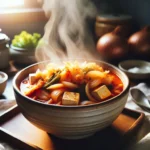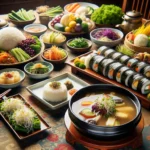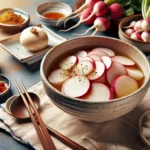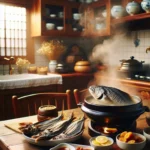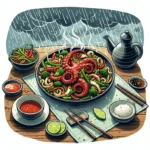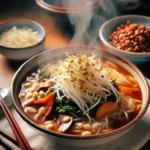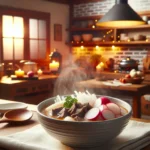Imagine a warm bowl of comfort, filled with the rich traditions of Korean culture. Tteokguk, or rice cake soup, is more than just a dish; it’s a symbol of new beginnings and good fortune. As we embark on this culinary journey, let us uncover the essential ingredients and step-by-step instructions that will transform your kitchen into a scene of joyous celebration. With tips to refine your technique and delightful variations to explore, this recipe promises to warm your heart and delight your senses. Join me as we dive into the enchanting world of Tteokguk!

Ingredients Needed for Tteokguk
To create a delightful bowl of Tteokguk, one must gather a variety of essential ingredients that harmonize to create a rich and inviting flavor profile. 🌟 The beauty of this traditional Korean rice cake soup lies not only in its taste but also in its symbolism, often representing renewal and good fortune during the New Year celebrations. As you embark on this culinary adventure, here’s a comprehensive list of ingredients you will need to achieve the perfect bowl of Tteokguk!
Essential Ingredients
- Rice Cakes (Tteok): The star of the dish, 300 grams of fresh or frozen sliced Korean rice cakes, will give your soup its unique chewy texture. Fresh is always best but if you can’t get it, frozen works just as well; just ensure to soak them in water for at least 30 minutes before using.
- Broth: An impeccable broth forms the backbone of your Tteokguk. You’ll need approximately 1.5 liters of beef broth or, for a vegetarian twist, you can opt for a flavorful anchovy broth. If you’re feeling adventurous, you might even try using a combination of both! The broth ideally should simmer for about 30 minutes to extract maximum flavor from the ingredients.
- Beef: Choose 200 grams of thinly sliced beef brisket. This cuts through the dish’s heart and adds a meaty richness. Try to get fresh cuts to enhance the flavor, ensuring to marinate it lightly with a pinch of salt and a dash of pepper for an extra depth before adding to the pot!
- Egg: One large egg is necessary for that beautiful garnish! Once fried, you can slice it into thin strips. The egg not only contributes to the presentation but provides a lovely creamy flavor that complements the soup.
- Green Onions: About 3 green onions chopped finely will not only brighten up the dish visually but also add a mild, fresh spiciness to the flavor. The contrast between the tender rice cakes and the crisp green onions is a match made in culinary heaven! 🌿
- Garlic: You will need 2 cloves of garlic, minced. Garlic adds a wonderful aroma and depth to your broth. For those who love a hint of warmth, feel free to add a bit more.
- Soy Sauce: About 2 tablespoons of soy sauce will impart a savory umami flavor to the Tteokguk. A splash of liquid can transform the dish; just be cautious not to overpower the delicate taste of the broth with it.
- Sesame Oil: Just a drizzle (1 teaspoon should do) of sesame oil to enhance the depth of flavor and offer a fragrant finish. The nutty aroma is simply irresistible! 🌰
- Salt and Pepper: To taste! Don’t forget to season wisely. A sprinkle of salt and a dash of black pepper will elevate the flavors just right.
- Optional Toppings: Feel free to get creative! Some might add a sprinkle of sesame seeds or even a few pieces of kimchi for an added kick. The choice is up to you! 🌶️
Each of these ingredients plays a specific role in crafting the delicate balance of flavors and textures that characterize Tteokguk. As you prepare to combine these exquisite elements, envision the comforting aroma that will fill your kitchen and the joy it will bring to the table. The Tteokguk not only nourishes the body but also warms the heart, perfect for cozy gatherings or festive occasions!
Step-by-Step Cooking Instructions
Embarking on the culinary adventure of preparing Tteokguk, or Korean rice cake soup, is not just a task; it’s a celebration of tradition and flavor! 🌿 Now, let’s dive into the detailed procedure that will transform your kitchen into a haven of delightful aromas and heartwarming vibes!
Step 1: Preparing the Broth
Start with the foundation of your Tteokguk — the broth! For a rich and flavorful base, you can use either beef or chicken. If you’re going with beef, opt for about 1 pound (450g) of brisket. Place it in a large pot with 8 cups (approximately 2 liters) of water. Add a couple of slices of ginger and 2-3 stalks of green onions for that extra flavor punch! 🌱 Bring it to a boil, then reduce the heat and let it simmer for at least 1.5 to 2 hours. This step is crucial as it allows the flavors to meld beautifully. Don’t forget to skim the foam that rises to the top — a clear broth is always a delight!
Step 2: Preparing the Rice Cakes
While the broth is simmering away, it’s time to turn your attention to the star of the soup — the rice cakes! Use around 8 ounces (225g) of ‘tteok’ (Korean rice cake), which can be found in many Asian grocery stores. If they are frozen, ensure to soak them in warm water for about 30 minutes to soften them. After soaking, slice them into thin pieces, roughly half an inch thick. They should be soft yet firm enough to hold their shape when cooked! 🍚
Step 3: Creating the Seasoning Mix
A perfectly seasoned Tteokguk is key to elevating its taste. As your broth simmers, mix together 2 tablespoons of soy sauce, 1 tablespoon of sesame oil, and a teaspoon of salt in a small bowl. Adjust according to your taste preference! This mixture will be a delightful addition to your dish later on.
Step 4: Cooking the Rice Cakes
Once your broth has developed a deep flavor, strain it to remove the meat and any impurities. Return the clear broth to the pot and add your sliced rice cakes. Let them simmer for about 10-15 minutes. During this time, the rice cakes will absorb flavors and become juicy and delightful! Be careful not to overcook them; you want them to maintain a slight chewiness! 🌟
Step 5: Adding the Finishing Touches
As the rice cakes are simmering, it’s time to bring back the beef (if using) into the pot. Thinly slice your cooked brisket and put it back in, along with your seasoning mix from earlier. Stir gently but decisively to combine all the elements together. One last thing: add a handful of sliced green onions and a sprinkle of black pepper for freshness and zing!
Step 6: Serving the Tteokguk
Your Tteokguk is now ready to be served! Traditionally, it is garnished with a sprinkle of fine sesame seeds and additional green onions for a finishing touch. Serve hot in deep bowls, making sure each bowl gets a good amount of those chewy rice cakes and tender beef! For that delightful visual and flavor contrast, you could even add some sliced egg — a beautiful golden yellow! 🍳
Exploring the world of Tteokguk is undoubtedly rewarding. Each step is a journey rich in flavors and history, leading to a dish that warms not only the stomach but also the soul. Enjoy the process and the fantastic results!
Tips for Perfecting Your Rice Cake Soup
Perfecting your Tteokguk (rice cake soup) is an art form that combines tradition with creativity. Many culinary enthusiasts often say the secret lies in the broth! A well-prepared broth can elevate your dish and transform it from ordinary to extraordinary. Start with a robust base—using a combination of beef, chicken, or even anchovy stock. For every liter of water, consider adding about 200 grams of meat or 50 grams of dried anchovies to introduce deeper flavors. Bring it to a simmer and let those ingredients mingle for at least 30 minutes, if not longer!
Choosing Quality Ingredients
Next, attention to detail in your ingredients can make all the difference. Opt for fresh, high-quality rice cakes (tteok) from a local Korean grocery store—this prioritizes texture and taste! Traditional Tteok is soft and chewy, and it should be soaked in water for 30 minutes to an hour before adding to the soup. This little step guarantees that each bite is pleasantly satisfying!
Seasoning to Taste
Seasoning the broth is where your own flair can truly shine. A standard practice is to incorporate soy sauce—2 tablespoons is a good starting point for seasoning, but don’t hesitate to adjust according to your palate. A pinch of salt and a touch of sesame oil can also enhance the overall flavor. Consider including a dash of gochugaru (Korean chili flakes) for a delightful kick! Spice lovers may rejoice as this can add a level of warmth and complexity to the dish!
Creative Garnishing
When it comes to garnishing, let your creativity soar! Bookmark a generous handful of finely sliced green onions, which not only adds a pop of color but also a hint of freshness. A sprinkle of toasted sesame seeds can add a nutty finish that complements the soup beautifully. For those who seek a more adventurous twist, try adding a beaten egg at the end! Just drizzle it into the simmering broth to create delicate ribbons of egg—what a visual treat!
Cooking Time Matters
Timing plays a critical role in ensuring the rice cakes achieve that perfect consistency. Once the broth is boiling, add the rice cakes and let them cook for about 5-7 minutes. It’s crucial to keep an eye on them, as overcooking can lead to a mushy texture! Nobody wants that in their Tteokguk, right?
A Meaningful Tradition
Lastly, remember that Tteokguk is often enjoyed during celebratory occasions, particularly the Lunar New Year. Sharing your beautifully crafted soup with family and friends invokes warm emotions and strengthens bonds. Each bowl symbolizes a wish for prosperity and success in the coming year. So, as the soup simmers away, relish in this meaningful tradition.
In essence, perfecting your rice cake soup is a delightful journey filled with rich flavors, personal touches, and cherished memories. The beauty of Tteokguk lies in its versatility—each pot can tell a different story. Whether you stick to the classic recipe or infuse it with your special ingredients, every bowl will carry the essence of tradition and innovation. Enjoy the process, and allow your culinary creativity to flourish! 🍲✨
Serving Suggestions and Variations
Elevating your Tteokguk experience can be both delicious and creative! Why not explore some serving suggestions that will not only tantalize the taste buds but also enrich the presentation? Let’s dive in!
Garnishes to Enhance Presentation
One popular approach is to serve your Tteokguk with an array of garnishes, transforming each bowl into a culinary masterpiece 🥣✨! Common toppings include thinly sliced green onions, toasted sesame seeds, and a sprinkle of gochugaru (Korean red pepper flakes) to add a touch of spiciness. For an extra dimension of flavor, consider drizzling a bit of sesame oil before serving—this will imbue the dish with a nutty aroma that is simply irresistible 🌾!
Protein Variations
If you’re looking to infuse some variety, think about using different proteins! Many families opt for a classic beef Tteokguk, but why not venture out of the ordinary? Add tender slices of chicken or even some fresh seafood like shrimp or clams! Each protein not only enhances the flavor profile but also brings a unique twist to the traditional recipe—perfect for those adventurous palates! 🦐🍗 What’s more, if you are keeping it vegetarian, hearty mushrooms, like shiitake or enoki, can make a delightful addition.
Side Dishes for Texture
Speaking of twists, have you considered adding a delightful crunch? Some prefer to serve Tteokguk alongside crispy fried dumplings (mandu) or seafood pancakes (haemul pajeon), creating a lovely contrast of textures! The warmth of the soup paired with the crispiness of these sides can elevate your dining experience to new heights! 🌊🥟
Rice Cake Variations
Now, let’s talk about variations regarding the rice cake itself. Traditional Tteokguk uses a flat, thin rice cake called tteok (떡), typically made with sweet rice flour. However, you can experiment with different types of rice cakes! For example, try using cylindrical or filled rice cakes which not only change the texture but also add unexpected flavors! 🎉
Seasonal Twists for Special Occasions
On special occasions such as Seollal (Lunar New Year), serving your Tteokguk with a seasonal twist could be a fun focal point! Adding ingredients like fresh vegetables—think vibrant carrots, colorful bell peppers, or even a bit of Napa cabbage—can bridge the traditional and modern elements! It looks stunning and tastes refreshing, making your meal not just a soup, but a celebration of flavors! 🌈🥕
Accompaniments for Extra Flavor
Let’s not forget about the accompaniment of sauces! While soy sauce is a traditional choice for dipping, a zesty kimchi-based sauce might just steal the spotlight! Imagine that tangy kick mingling with the soft, chewy rice cake—a match made in culinary heaven! This can introduce a layer of depth, ultimately making the experience uniquely yours 🎊.
Temperature Considerations
As you serve your Tteokguk, consider the temperature as well. Some traditions suggest enjoying it piping hot, while others might serve it at a slightly cooler temperature, allowing for the intricate flavors to shine through more distinctly. Try both methods and see which resonates more with your guests! The magic of food lies in the experience, and these subtle adjustments can take the dining experience to a whole new dimension! 🔥🌡️
In summary, Tteokguk is not just a dish; it is an opportunity for creativity, personal expression, and delightful exploration! Encourage everyone at the table to customize their own bowl with toppings, proteins, and garnishes. Dive into the journey of flavors and textures—there’s no wrong way to enjoy this beloved Korean staple! Thus, the possibilities are infinite, and every bowl can tell a different story! 🍽️💖
As you embark on your culinary journey to create the delightful Tteokguk, remember that each ingredient not only contributes to the dish but also tells a story of tradition and celebration. This soup, filled with rich flavors and textures, invites you to savor moments with family and friends.
Don’t hesitate to infuse your own twist into this age-old recipe, whether through colorful vegetables or unique seasonings. The magic of Tteokguk lies in its versatility, allowing it to adapt to each cook’s personal touch.
So, gather your ingredients, channel your creativity, and let the spirit of Korean cuisine guide you. May your Tteokguk be a source of warmth and joy, inviting all to partake in its delicious embrace. Enjoy the journey as much as the meal itself. Bon appétit!
